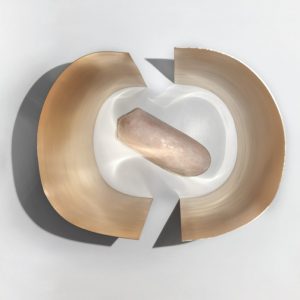
Sometimes concepts such as memory or time pass through a path of creation that finds in matter new possibilities of reflection. In this way the artistic research can investigate issues related to the ambiguity and vulnerability of the human condition, the transcendence of reality and present, the relationship between the visible and the invisible. This creative process characterizes the works of Elena Modorati, a conceptual artist who, through an intimate and minimalist approach, manages to shape not just the perception of existence, but also of art itself.
The variety of materials used becomes the essential element of her works. In fact, we move from wax to rice paper, from clay to marble, from plaster to brass, to stone. Her works have been featured in many personal and collective exhibitions. Among these are “Resti” (2020), “Pan orem” (2019), “Paia” (2018), “Comfort zone” (2017), “Le voci della luce” (2017), “Crossing the Water” (2013). In these exhibitions her creations seem to dissolve the deep interweaving of a subjective existential dimension, and open up to another spiritually universal one. Let’s talk with the artist.
In your works you use materials that seem to assume intelligible but unusual expressive forms, involving and at the same time ambiguous. How does your creative process start?
The material is the foundation, the transmission channel that is expressed through a specific modality. With the work is created a dialogue of sensitivity, a graft is produced that deactivates the rhetorical risks of intention. I am very mental, I tend to proceed by projects. The manual phase is not just a check, but each time is a new experience.
Your works mainly focus on issues related to memory, time, reality and existence, tending to a suspended dimension in which you can feel the emotional value of what, both in life and in art, is perceived as elusive or imperceptible. How does the visual aspect of the work transcend the analytical one?
I believe that ambiguity and suspension are generated by this approach, although they confirm, but secondarily, an analytic assumption. Art that literally takes shape in the dimension of the object, in order to function cannot but tune to this band.
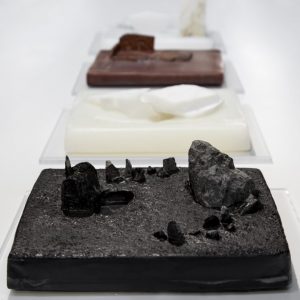
“Resti” is the title of one of your personal exhibitions at the Gaggenau DesignElementi Hub in Milan (2020), where fifteen works give life to a minimalist exhibition, but capable of generating a silent, profound, almost spiritual narrative. In fact, they range from the wax and black stone Altar, to the plaster and wax Rocchi belonging to the Capricci series, from the brass Omphalos sculpture, to the cycle of works made of paper and wax entitled Calendars. Can you tell us about these works and how they manage to shape metaphysical concepts?
Not metaphysics, but certainly a spiritual dimension, a sacred, physical and temporal concept around which turns all my work. A concept that is partly a limit, negative (like the negative of a cast), which can be named through the vital tension – we can think of the romantic sehensucht – or the term beyond; partly positive, such as purity, unspoken, helpless and silent life. It is a rather complex question that involves an interpretation of the human and the concept of civilization, and sees in art the mysterious, prodigious reagent that illuminates, without giving answers where actually there cannot be one. I would say that the artistic act is the laic rite that incessantly questions the sacred, highlighting the parallel theme of expression and meaning. Hence existence, history, time, relationship between individual and collective, subject, world, species.
Wax is one of the materials you use the most in your artistic practice, introducing a new way of conceiving reality and individuality. What expressive possibilities does this material element allow?
Wax is a visceral and allusive material: the depth of the semi-transparency is indolent and indefinite. It is permeable (when in reality it is refractory!), almost attracting the light and, effectively returning it, the perimeter of shapes plays with it, fading and blending with the environment. Therefore a soft, diaphanous material, a little melancholic and very relational.
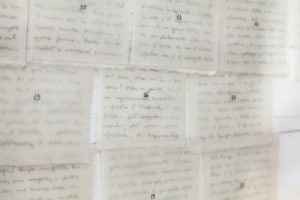
Time is another recurring theme in your work. For example, in the cycle of works entitled Calendars, the pages of a visual diary made of thoughts, reflections and phrases typical of a personal, intimate and emotional experience, seem to float in a timeless dimension. So what does time express in your creations?
There is a tragic discrepancy between perceived, lived, and conventional time, codified and shared. My personal time, slow to the limit of immobility, is my bulky symptom. Time can be read as history and as an hourglass, as roots and as an inevitable biological expiration, and therefore it calls into question the distance between the individual and the community. Together with space, time is the coordinate of the measure of things, but for quantum physics it does not exist. Time is then rhythm, cycle, narration, time of the seasons, of light and dark, of the breath. It is memory, project, dialectic of presence and absence, and at the same time indivisibility from opposites. How can we ignore it? Calendars, in particular, take their inspiration from the Advent calendars for children, in which opening a box every day reveals a hidden image, a surprise. In mine, on the contrary, the overlapping of the sheets of paper, always corresponding to the days, cannot be “opened”: the surprise is already there, in the same dimension of the mystery, of the “covered”.
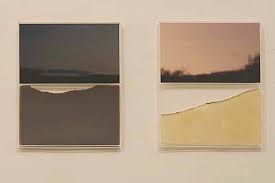
Pan orem (2019) is an exhibition set up at the Il Milione Gallery in Milan where three different types of installations, individual but interdependent, become a reflection on the concept of gaze and the intrinsic possibilities of vision. How did you conceive the works of this exploratory journey?
For several years I believed I was working on the limits of knowledge, of which the dynamics of vision were the emblem. Then I realized that I had misunderstood the question, that the impossibility of a certain, definitive “hold” is coessential to reality, it indicates its nature, the vision that is never clean, the sensation of a “fog” that clutters the field, captures the ephemeral and ambiguity of everything, gaze included. Fog is like the common membrane that connects us and the world. At this point, thought and vision are no longer superimposable. The title Pan orem (hence the Italian word panorama), which means to see everything, introduces some vision exercises that keep in check prejudice and habit, that lead to a physical and mental shift of perspective. Through the juxtaposition of opposites – day and night, thickness and depth, past and present, opacity and transparency, attraction and repulsion, invitation and prohibition, the viewer is accompanied to sharpen attention, in a short “initiatory” journey.
Into your exhibition space the viewer seems to take an active attitude, dissecting the very essence of the work and consequently experiencing his own emotions. Is that true?
Certainly my work requires some action, that is an approach; it is not an imposition. How effective it is … I can only wish for it!
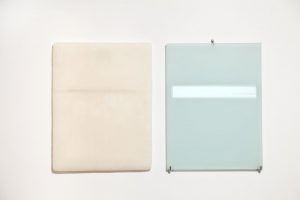
Instead in the exhibition Paia inaugurated at ProgettoArt Elm in Milan in 2018, the series of works on display are presented as sequences of a unique narrative, which seems to be moved by a desire for a more intimate communication. Can you tell us about it?
Actually, in that case it was an autobiographical project, but somehow every project is. Just like every time, if the conditions are right, I build my exhibitions according to a unitary discourse, working on the specific space and on the development of intertwined issues. Let’s say that it is a question of different declination, of different accents, but then the great themes that you can find into a work are the points of a sense around which we turn, perhaps with a gradual approach, great obsessions that follow us through all your life. Paia elaborated the end of a love, but it is also a general reflection on the theme of the relationship, as well as, for example, my production of still life or, absolutely, every installation procedure.
Which artists have influenced you and from which you draw inspiration?
Mentioning some specific names is a bit simplistic. I feel that I have a total debt to the whole history of art. All the artists that I have loved and that I love, the readings, the places, but also towards everything that irritated me, because in any case it provoked me to make a critical study. From archeology to poetry, from architecture to cinema, to decorative arts, everything has influenced me! And if I have to think of the living artists that I particularly admire, Roni Horn and Paolo Icaro immediately come to my mind.
Can you tell us about your future projects?
I have some projects planned, of different nature, but what matters to me is that I am experiencing a phase of extreme inner restlessness that I am trying to translate into work. The challenge is to make work evolve, to force its boundaries, both in the direction of a greater conquest of myself, and of a further opening to history, to the world to which I belong.
[foogallery id=”4125″]
Biography: Elena Modorati was born in Milan 1984, where she still lives and works. Graduated in Philosophy at the University of Milan, she has been collaborating with Cramum since 2014 taking part in two important exhibitions curated by Sabino Maria Frassà: Pulvis Es in 2014 and Il cielo sopra di me e dentro di me che cosa? in 2019. In 2014 images of her works accompanied the monographic issue (In) actualités de Derrida of the magazine “Rue Descartes” on the occasion of the tenth anniversary of the philosopher’s death. Her pieces are part of numerous public and private collections including the collection of Palazzo Ducale, Gubbio and the Pinacoteca of Monza. Among her most important exhibitions are: BAG Bocconi Art Gallery, in 2014, Università Bocconi, Milan, Musée d’art contemporain Arteum, Châteneuf-le-Rouge, Aix-en-Provence, curated by Christiane Bourbon and Arafat Sadallah, Italian Insitute of culture, Mexico City, curated by Raffaella De Chirico; Kairos, Le supermarché des images, nel 2020, Jeu de Paume, Paris, from a project by Peter Szendy, Emmanuel Alloa and Marta Ponsa.